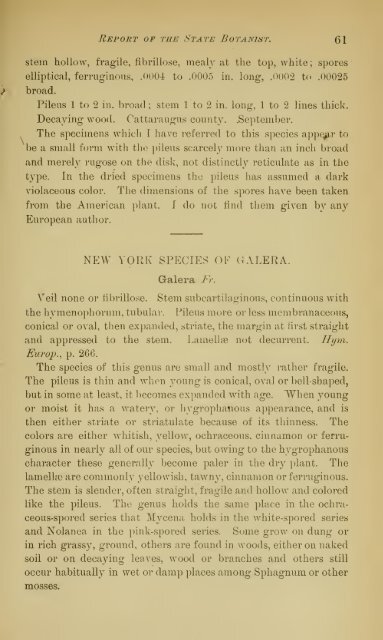Annual Report of the State Botanist 1892 - MykoWeb
Annual Report of the State Botanist 1892 - MykoWeb
Annual Report of the State Botanist 1892 - MykoWeb
You also want an ePaper? Increase the reach of your titles
YUMPU automatically turns print PDFs into web optimized ePapers that Google loves.
<strong>Report</strong> <strong>of</strong> <strong>the</strong> <strong>State</strong> <strong>Botanist</strong>. 61<br />
stem hollo^y, fragile, fibrillose, mealj'^ at <strong>the</strong> top, white ; spores<br />
elliptical, ferruginous, .OOOi to .0005 in. long, .0002 to .00025<br />
broad.<br />
Pileus 1 to 2 in. broad ; stem 1 to 2 in. long, 1 to 2 lines thick.<br />
Decaying wood. Cattaraugus county. .September.<br />
The specimens which I have referred to this species a])p^r to<br />
be a small form with <strong>the</strong> pileus scarcely more than an inch broad<br />
and merely rugose on <strong>the</strong> disk, not distinctly reticulate as in <strong>the</strong><br />
type. In <strong>the</strong> dried specimens <strong>the</strong> pileus has assumed a dark<br />
violaceous color. The dimensions <strong>of</strong> <strong>the</strong> spores have been taken<br />
from <strong>the</strong> American plant. I do not find <strong>the</strong>m given by an}'^<br />
European author.<br />
NEW YORK SPECIES OF GALERA.<br />
Galera Fr.<br />
Veil none or fibrillose. Stem subcartilaginous, continuous with<br />
<strong>the</strong> hymenophorum, tubulai-. Pileus more or less membranaceous,<br />
conical or oval, <strong>the</strong>n expanded, striate, <strong>the</strong> margin at first straight<br />
and appressed to <strong>the</strong> stem. Lamellae not decurrent. Ilym.<br />
Europ., p. 266.<br />
The species <strong>of</strong> this genus are small and mostly ra<strong>the</strong>r fragile.<br />
The pileus is thin and when young is conical, oval or bell-shaped,<br />
but in some at least, it becomes expanded with age. "When young<br />
or moist it has a watery, or hygrophanous appearance, and is<br />
<strong>the</strong>n ei<strong>the</strong>r striate or striatulate because <strong>of</strong> its thinness. The<br />
colors are ei<strong>the</strong>r whitish, yellow, ochraceous, cinnamon or ferru-<br />
ginous in nearly all <strong>of</strong> our species, but owing to <strong>the</strong> hygrophanous<br />
character <strong>the</strong>se generally become paler in <strong>the</strong> dry ])lant. The<br />
lamella) are commonly yellowish, tawny, cinnamon or ferruginous.<br />
The stem is slender, <strong>of</strong>ten straight, fragile and hollow and colored<br />
like <strong>the</strong> pileus. The genus holds <strong>the</strong> same place in <strong>the</strong> ochra-<br />
ceous-spored series that Mycena holds in <strong>the</strong> white-spored series<br />
and Nolan ea in <strong>the</strong> pink-spored series. Some grow on dung or<br />
in rich grassy, ground, o<strong>the</strong>rs are found in woods, ei<strong>the</strong>r on naked<br />
soil or on decaying leaves, wood or branches and o<strong>the</strong>rs still<br />
occur habitually in wet or damp places among Sphagnum or o<strong>the</strong>r<br />
mosses.
















